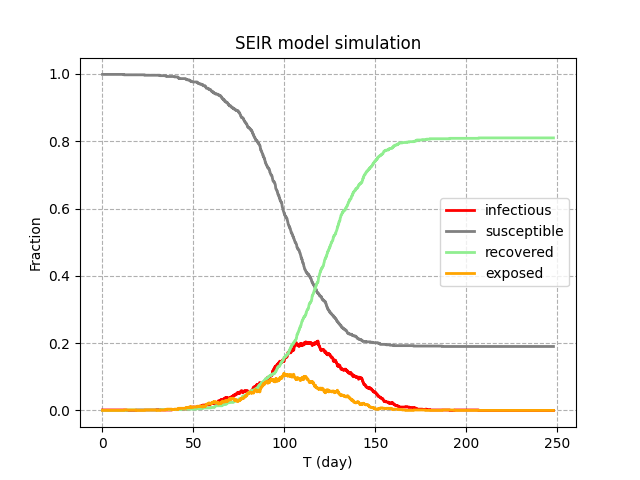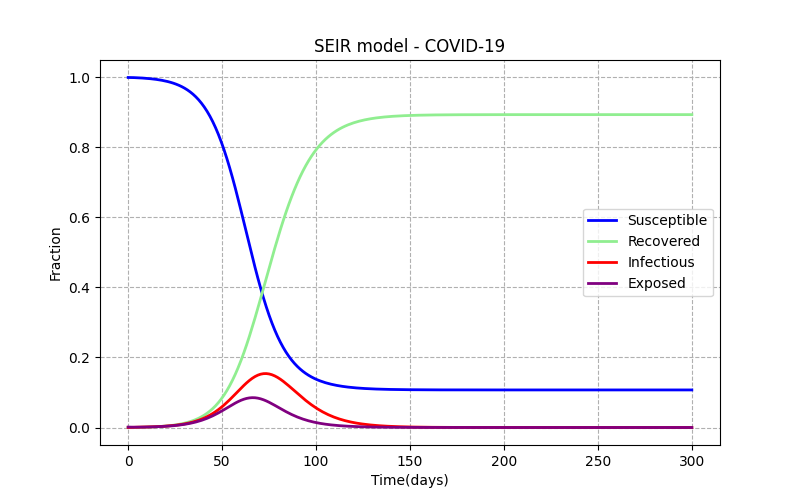COVID-19 SEIR 모델 pygame 시뮬레이션
개요
SEIR 모델을 전세계적으로 유행 중인 COVID-19에 적용(델타 변이 x)
R0 = 2.5
incubation period = 4
infectious period = 8
초기 인구 800
초기 감염자 1
이동속도 = 2
모든 초기 정보는 출처가 CDC.
R0의 경우 CDC가 간주한 다섯 가지 시나리오 중 현재에 가장 적합한 시나리오 5를 채택하였음
실행 동영상
실행 동영상
결과

밑의 결정론적 해석으로 그린 그래프와 거의 일치한다

소스코드
import time
import pygame as pg
from math import dist
from random import *
import numpy as np
from infection_graph import graph
from glob import glob
import copy
##### 18sec = lDay !!!!!
# text = open('C:/Users/helis/Desktop/python/arc/infection_histogram/a.txt', 'a')
# file_list = glob("*.py")
c_size_x = 1200
c_size_y = 800
def timeshow():
return time.time()
age_lim = 50
number = 800
r = 2
start_time = timeshow()
frame = 0
'- <Infection information> ------------------------------------------------------------------------------'
u = 0.0 # social distancing
t_incubation = 4*18*60 # 평균 지연시간 (4일)
t_infective = 8*18*60 # 평균 전염 가능 시간
R0 = 2.5
# initial number of infectious and recovered individuals
e0 = 1/number
i0 = 0.00
r0 = 0.00
s0 = 1 - e0 - i0 - r0
x0 = [s0,e0,i0,r0]
alpha = 1/t_incubation # 감염 가능성
gamma = 1/t_infective # 회복률
beta = R0*gamma # 감염률
'- <Pygame initation> -----------------------------------------------------------------------------------'
pg.init()
screen = pg.display.set_mode([c_size_x,c_size_y])
title = 'infection_simulation'
pg.display.set_caption(title)
clock = pg.time.Clock()
SB = 0 # 상태함수, 0이 되면 프로그램 종료
'- <CLASS> ----------------------------------------------------------------------------------------------'
class people(object):
def __init__(self, r, age, sex, xp, yp, st):
self.age = age
self.sex = sex
self.p = np.array([xp, yp])
self.v = 2
self.st = st # S = 취약군, E = 접촉군, I = 감염군, R = 회복군
self.r = r
self.dst = np.array([randint(0,c_size_x), randint(0,c_size_y)])
self.since_infectious = 0
self.since_exposed = 0
self.c = []
def color(self):
if self.st == 'S':
self.c = [120,120,120]
elif self.st == 'E':
self.c = [255,200,0]
elif self.st == 'I':
self.c = [255,0,0]
elif self.st == 'R':
self.c = [100,220,100]
def show(self):
pg.draw.rect(screen, self.c, [self.p[0]-self.r/2, self.p[1]-self.r/2, self.r, self.r])
def state(self):
if self.st == 'I':
self.since_infectious += 1
if self.since_infectious >= t_infective:
self.st = 'R'
ppl_R.append(self)
ppl_I.remove(self)
elif self.st == 'E':
self.since_exposed += 1
if self.since_exposed >= t_incubation:
self.st = 'I'
ppl_I.append(self)
ppl_E.remove(self)
def move(self):
if dist(self.p, self.dst) < self.v:
self.new_dst()
else:
delta_dist = np.array([round((self.dst[0] - self.p[0])*self.v, 1), round((self.dst[1] - self.p[1])*self.v,1)])
self.p += delta_dist/dist(self.p, self.dst)
def new_dst(self):
self.dst = np.array([round(uniform(0, c_size_x),1), round(uniform(0, c_size_y),1)])
def infect(self):
if self.st == 'I':
for a in ppl_S:
if dist([self.p[0], self.p[1]], [a.p[0], a.p[1]]) < r and uniform(0,1) < beta*60: # 감염확률적용
if self.st == 'I' and a.st == 'S':
a.st = 'E'
ppl_S.remove(a)
ppl_E.append(a)
elif self.st == 'S' and a.st == 'I':
self.st = 'E'
ppl_E.append(self)
ppl_S.remove(self)
'- <FUNCTION> --------------------------------------------------------------------------------------'
def show():
for people in ppl:
people.color()
people.state()
people.infect()
people.show()
people.move()
'- <INITIATION> --------------------------------------------------------------------------------------'
ppl = list()
for i in range(number):
ppl.append(people(r, randint(0,age_lim), choice([0,1]), uniform(r/2, c_size_x-r/2), uniform(r/2, c_size_y-r/2), 'S'))
ppl_S = copy.copy(ppl)
ppl_I = list()
ppl_E = list()
ppl_R = list()
time_rate = list()
data = list()
ppl_S[0].st = 'I'
ppl_I.append(ppl_S[0])
ppl_S.remove(ppl_S[0])
'- <RUN> ---------------------------------------------------------------------------------------------'
while SB == 0:
clock.tick(60) # fps 설정
passed_time = timeshow() - start_time
screen.fill([240,240,240])
font = pg.font.Font("C:\Windows\Fonts\Arial.ttf",20)
text = font.render("S : {}".format(len(ppl_S)),True, [0,0,0]) #텍스트가 표시된 Surface 를 만듬
screen.blit(text,(1100,10))
text = font.render("E : {}".format(len(ppl_E)),True, [0,0,0]) #텍스트가 표시된 Surface 를 만듬
screen.blit(text,(1100,30))
text = font.render("I : {}".format(len(ppl_I)),True, [0,0,0]) #텍스트가 표시된 Surface 를 만듬
screen.blit(text,(1100,50))
text = font.render("R : {}".format(len(ppl_R)),True, [0,0,0]) #텍스트가 표시된 Surface 를 만듬
screen.blit(text,(1100,70))
for event in pg.event.get(): # User did something
if event.type == pg.QUIT:
SB = 1
elif event.type == pg.MOUSEBUTTONDOWN:
print([len(ppl_S), len(ppl_E), len(ppl_I), len(ppl_R)])
print(data)
frame += 1
if frame % 10 == 0:
data.append([frame, len(ppl_I), len(ppl_S), len(ppl_R), len(ppl_E)])
if len(ppl_R) == 800:
print(data)
SB = 1
show()
pg.display.flip()